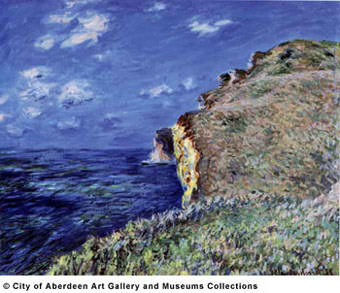
Lesson #5
Claude Monet (mow-NAY)
French, 1840-1926
The Cliff at Fécamp, 1881
Oil on canvas
25 5/8 x 32 in.
City of Aberdeen Art Gallery and Museums Collection, Aberdeen, Scotland
Subject
This cliff painting is one of a series created at Grainval, just south of Fécamp on the Normandy coast.
It reflects the artist’s philosophy that "landscape is nothing but an impression - an instantaneous one." Monet waited and watched the shifting sun and shadows and then quickly brushed in the moment he wanted. He liked to paint the same scene many times so he could study the effects of changing light and weather. Children frequently trailed the artist and carried his canvases.
Style
The writer Guy de Maupassant also followed Monet in his quest for impressions and vividly described the artist's gifts: ÒHe would pick up with a few strokes of his brush the falling sun ray or the passing cloud, leaving aside the false and conventional.
I saw him seize a sparkling downpour of light on the white cliff and fix it in a shower of yellow tones which made the effect of this fleeting and blinding marvel seem strangely astonishing. This painting is Monet's reaction to a brisk spring day at Fécamp, as the breeze ruffles the sea, and clouds tumble by in a luminous sky. Like a true Impressionist, he has applied brushstrokes of brilliant blue, green, and yellow in contrasting patterns. Some viewers can see animal-like shapes in the rocks of The Cliff at Fécamp, perhaps the only sign of life in a scene that is without human evidence.
The swirling ambiguity of cliffs and sea is dizzying and adds to the sense that we are there. Notice the off-center composition of the cliffs against the sea. Like other Impressionists, Monet was probably influenced by the asymmetrical compositions of popular Japanese wood-block prints.
Artist
Technological advancesÑportable easels and metal tubes that stored paint indefinitely allowed Impressionists like Monet to take extended painting trips outdoors. A wide range of pigments was also available, though Monet used a small, typical Impressionist palette of eight to ten colors.
"The real point," he wrote a friend, "is to know how to use the colors." Despite failing eyesight, the artist painted well into his eighties. The public discovered his work by 1890, and his fortunes quickly improved. By 1920, the painter who once had struggled to feed and clothe his family complained about the "too-frequent visits from buyers who often disturb and bore me."
Looking Questions
- Describe the shapes that you see. What shapes are repeated?
- Notice brushstrokes of warm colors next to brushstrokes of cool colors.
- Name two colors that
- Where do the colors contrast?
- Do you see any outlines?
- Look carefully at the textures of the plants, rocks, water, and sky. How do the brushstrokes describe different textures?
Activities
The Arts
Join the students as you pick up an imaginary brush and pretend to paint this painting. Next, take the students outside (or work from visual re- sources like old calendars) to create a landscape using acrylic, tempera paint, or oil pastels. Look for different textures and colors as students paint directly on the paper or canvas without sketching in outlines. After they finish, have the students look at the painting again. What do they notice now about the painting that they didn’t notice at first?
Math or Science
Scientists John Dalton, Stanisloa Cannizzaro, and Amedeo Avogadro all worked in Europe at the same time as the Impressionists did.
The Impressionist painters were interested in how smaller parts (like brushstrokes, bits and blobs of paint, and colored dots) make up the whole (a painting). The scientists made discoveries about atoms (smaller parts) and matter (the whole). Have the students make four headings on their paperÑgas, liquid, solid, other. Next, analyze this whole painting by listing its smaller parts. Write under each of these four headings the parts that apply to it. For example, list breeze, air, and atmosphere under the heading of gas. Use the same headings and analyze other works in this set.
Language Arts
Tell the students to imagine jumping into the painting. How would it feel to be on these cliffs? What would the ground feel like? Is it warm or cool? Where is the light coming from? How does the scene smell? How is the weather? Ask the students to explain their thoughts by writing a paragraph that describes the experience of jumping into the painting.
Social Studies
Have the students look at the land in the painting. Notice the plants, rocks, and view of the water. Imagine that the class owned the land represented in the reproduction. Generate a list of ways to use the land. Will it be kept as open space, become a park, or be developed into a resort hotel? What other uses can you think of? Vote on how you would use the land.
Continue reading on to the next page, #6: Cezanne, Still Life with Pears.
